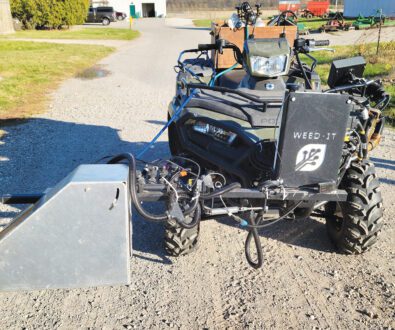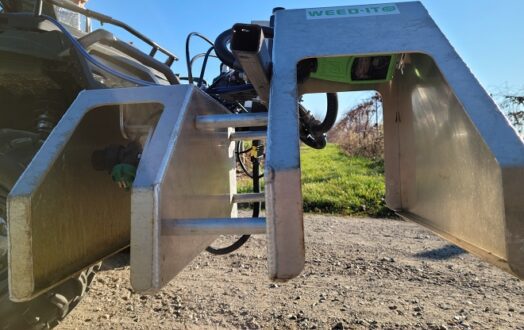Jul 10, 2023Vision-guided herbicide sprayer senses pesky weeds
Precision spraying has reduced total herbicide use for row crop operations compared to broadcast applications, without negatively impacting weed control or crop fitness and yield.
Determining how these systems work in perennial crops, including fruits such as blueberries, apples and grapes, has spurred studies by a Michigan State University (MSU) weed scientist.

Sushila Chaudhari, assistant professor and weed scientist in the MSU Department of Agriculture, shared early results of her study of a chlorophyll fluorescence-sensing herbicide sprayer during the International Fruit Tree Association’s conference in Grand Rapids, Michigan, in February. She further outlined its potential during an MSU Spring Blueberry online Extension webinar in early April.
By reducing the use and cost of herbicides and improving crop safety by reducing off-target movement, farm operators can experience needed efficiencies in targeting one of their top nemeses — weeds, Chaudhari said.


Precision weed management technology that features plant detection based on chlorophyll has led to new products on the commercial market including WEED-IT Quadro by Weed-it Ag System, WeedSeeker by Trimble Ag Solution and See & Spray by John Deere.
More advanced weed species identification technology is still being developed by Blue River Technology and John Deere, but is not available on a commercial basis. This technology features deep learning algorithms to enable recognition of not only the presence but also the identity of different weeds within crops.
There has been limited research done in specialty crops. Studies done in Arizona revealed precision spraying could reduce total herbicide applications without negatively affecting weed control efficacy or crop fitness and yield.
Chaudhari’s goal was to enhance the knowledge about the use of vision-guided sprayers (VGS) in perennial crops. She studied the effect of application timing on VGS sprayer sensitivity to accuracy and evaluated the system’s weed control efficacy and crop safety. The herbicide efficacy of the VGS was compared to traditional broadcast applications.
Chaudhari opted to use the WEED-IT Quadro in her research because of its simplicity of design and use. The unit detects chlorophyll in the leaves of actively growing weeds. The chlorophyll reacts by emitting a near-infrared signal, which is received and analyzed by the sensors. Spray booms connected to the sensors are activated to target the weeds. The sensor will tell the sprayer to activate or not before spraying.
The unit is mounted on an all-terrain vehicle. One sensor can control four spray nozzles. Each nozzle covers 25 centimeters of area. It has four independent
sensing zones that consist of a 3.3-foot swath width. The system evaluated different weed densities in apples (weed density was low), blueberries (weed density was moderate using a black plastic weed cloth) and grapes (weed density was high). Applications were conducted in spring, summer and fall (except
in apple).
Chaudhari’s preliminary conclusion was that crop safety was similar from VGS and using a backpack sprayer (BPS). In blueberries, less than 5% crop injury was reported regardless of the method of application and herbicide treatments.


Weed control efficacy with VGS (WEED-IT Quadro) is similar or higher compared to standard banded BPS. VGS used constantly higher sprayer volume (increased herbicide use) compared to BPS regardless of weed density or production systems.
“The WEED-IT Quadro’s weed control efficacy was similar to or higher than the backpack sprayer’s,” she said. “The take-home message on this is that the backpack sprayer consistently used less spray volume as compared to the vision-guided sprayer,” she said.
The reasons behind using the higher volume with the visionguided sprayer involved the settings that the researchers used.
“A higher sensitive nozzle setting on the vision-guided sprayer may have been detecting a small chlorophyll and using more spraying,” she said. “The detection zone is very wide at 25 centimeters. If the sensing unit is detecting a small amount of chlorophyll on a small weed, it’s going to get detected and sprayed. We think these are the reasons the vision-guided system has used more spray than the backpack sprayer.”
Chaudhari’s work will lead to further evaluation of the Quadro’s settings and their effect on weed control and herbicide volume.
The project was funded by the Michigan State Horticultural Society, Michigan Blueberry Growers, the Michigan Apple Committee and the U.S. Department of Agriculture’s National Institute of Food and Agriculture.
— Gary Pullano, FGN senior correspondent














